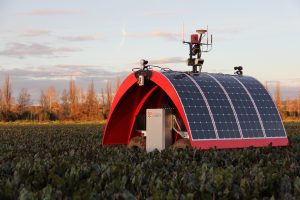Researcher of the Year award feature: Salah Sukkarieh
Professor Salah Sukkarieh
New South Wales
2014

Salah Sukkarieh is a Professor of Robotics and Intelligent Systems at the University of Sydney. In 2014, Salah was awarded the Researcher of the Year award for his work on intelligent farm robots, in particular the ‘Ladybird’ – a lightweight solar-electric robot that uses intelligent perception to guide its activities.
Fast-forward to 2022, and Salah is still very much active in the field of ag robotics. He has added elements of extension into novel robotic tools for crop production processes, and artificial intelligence (AI) techniques for crop intelligence.
Since winning the award nearly eight years ago, Salah has led several industry-funded R&D projects looking at the applications of these technologies in mining (Rio Tinto), Flight Planning (Qantas), drones for environment monitoring (various government grants) and robotics for Agriculture (Hort Innovation, Meat & Livestock Australia and Grains Research and Development Corporation).
“Currently we have a number of high technology readiness level robotic demonstrators in agriculture looking at intelligent sampling, spraying and animal tracking. The latest R&D is focusing on how real time crop intel can benefit real time decision making of the robot in the field,” Salah explains.
Award reflection
When Salah was recognised for his achievements, the ag robotics discussion was just beginning for the Australian vegetable industry.
“There was uncertainty over whether the technology could work and – if it could – to what level,” Salah says.
“There were some commercial and research elements locally and overseas, but they were still focusing on the automation of a tractor-like platform.”
Salah’s award followed the conclusion of the first Hort Innovation-funded investment on a dedicated robotics platform for the vegetable industry, entitled An intelligent farm robot for the vegetable industry (VG12104). This is when the Ladybird robot was born.
“This was the first dedicated robotics and AI platform that focused on making a system that could in real time detect and act on individual plants,” Salah says.
“The award was recognition of the how the industry and research came together to deal with a very difficult technical challenge, as well as recognition that the tide was turning in our understanding and desire of automation on-farm.”
Further research
Since 2014, Salah’s research has focused on five areas that need to be seen collectively to bring together a coherent and optimised solution. These include:
- The platform including the energy and drive system – this has focused on the research and development of the structure of the platform for low energy motion on vegetable rows, as well as the battery and motor system combination.
- Autonomy and safety – optimal motion planning for the robot to reduce energy consumption, and safety sensors for collision detection and avoidance.
- The sensors, data analytics, and machine learning – types of sensors to use for detection of different plant features, and the AI algorithms that use this information to determine plant properties such as size, height, yield, pest and diseases.
- The intelligent tools – development and testing of new tools for precision mechanical weeding, spraying and harvesting.
- Automated Decision Support – a relatively new area that is coupling ag science with machine learning to give the robot the capability of undertaking real time agronomy actions.

vegetable industry.
While the first four areas of still an active part of the research, Salah says the decision support element is now taking on more interest.
“This is where we start to add greater intelligence into the robot to act on the information it is seeing,” he says.
“As an example – if we knew that by the fifth week of production in a particular location on farm, the average crop yield should be a certain number.
“The robot is detecting the yield of each plant in real time, and we’re investigating if the robot can make a decision (e.g. spray, remove, alert) on each plant to ensure uniformity in yield or maximising yield.”
Working in the robotics space has its challenges.
“Ag robotics is the nexus of AI, robotics, biophysical systems, field operations, and business requirements. The complexity requires social, economic and environmental solutions to come together in a unified manner,” Salah says.
However, Salah enjoys working with the vegetable sector – particularly alongside the growers.
“They are great, down-to-earth people who are highly experienced systems thinkers. And they want this technology to work.”

Looking ahead
Over the past eight years, Salah and his research team have been fortunate to receive a series of projects built upon each other to allow an idea to go to complete field prototype.
Along the way, there were a couple of projects – undertaken by Salah and his team and other researchers – that looked at novel sensing techniques to measure diseases in the field in real time.
“I believe this type of research, as well as the extension to measure quality in real time, would be an important area to keep focusing on,” Salah says.
“As the Automated Decision Support tools get better, we will be able to close the loop on the whole research area and get to a point where the research will focus on robots making timely decisions about when and how to operate.”
About the award
The Bayer Researcher of the Year award recognises a leading agricultural researcher who has helped to advance the industry through their work, and actively encourages growers to implement research outcomes on-farm. Award nominations are now open, closing on 15 April. Click here for further details.
Cover image: Professor Salah Sukkarieh demonstrates how low-cost robotics and smartphones with AI can benefit farmers in developing countries. All images courtesy of Professor Salah Sukkarieh, the University of Sydney.

